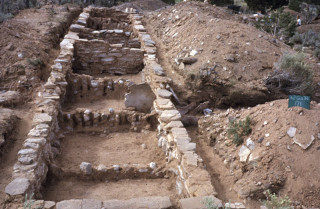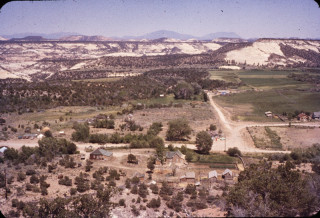Explorer Corps Marker: Garfield County
Find the Marker
The Garfield County marker is at the Anasazi State Park Museum. It highlights Coombs Village, an Ancestral Puebloan site in the area that is replicated directly behind the Museum. The Museum sits on Highway 12 in Boulder, just three minutes north of the Boulder Post Office.
GPS 37°54’39.0528”N 111°25’25.3164”W
Dig Deeper
What happened at Coombs Village? Archaeologists have been pondering this question for decades. This place, located in Garfield County, was once a bustling center of Native American trade. Then, after two centuries, the village was abandoned and burned.

The significance, and mystery, of Coombs Village didn’t come to archaeologist’s attention until in the middle of the 20th century. In 1957 and 1958, archaeologists from the University of Utah excavated the site as part of the Upper Colorado River Basin Salvage Project – an attempt to document, study, and collect sites on the north and west sides of the Colorado River before the construction of the Glen Canyon Dam.
Part of what made Coombs Village of special interest was its location. The remnants of the village are located near Torrey and Capitol Reef, within an area that contains many archaeological sites made by people of the Fremont culture. Experts wondered if Coombs Village might offer some new insights into the lives of those people or connections between other cultural groups through the Southwest. As excavations continued, though, the archaeologists realized that their expectations were off. Coombs Village was a focal point for the Kayenta Anasazi people, and is one of the largest villages of its type west of the Colorado River.
So far as archaeologists have been able to reconstruct, Coombs Village was first established about a thousand years ago in AD 1075. Within 25 years, the place was absolutely bustling. Ceramics found within the Coombs Village excavations matched types of pottery found elsewhere in the southwest. Some of the pieces resembled those found in the San Juan area of Utah to the southeast, while others resembles those found in to the southwest. Such finds, archaeologists hypothesized, indicated that Coombs Village was a major trade center between communities who lived in the Southwest at the time.

By AD 1235, about 160 years after the village was established, Coombs Village was abandoned. In fact, much of the village was burned. Over half the structures examined during study of the site show signs of fire, even building that seem to have still been occupied at the time. Archaeologists don’t know why. There are no signs of violence at the site, no sign that the village had been attacked or burned in conflict. Instead, the burning may have been to bring this place’s role to a close – a symbol of moving on. In fact, archaeologists note, the Kayenta Anasazi people were moving further south around this time. Perhaps the story of Coombs Village is part of that greater movement.
The last excavations at Coombs Village were carried out by the Anasazi State Park when the Visitor Center was expanded. And to this day, all the collections from the excavations are kept there – a connection to a town that flourished and faded not so very long ago.
Want to Go Farther?
The actual Coombs Village is not open to the public to help protect this important site. Visit the Natural History Museum of Utah to learn more about the peoples who call Utah home.